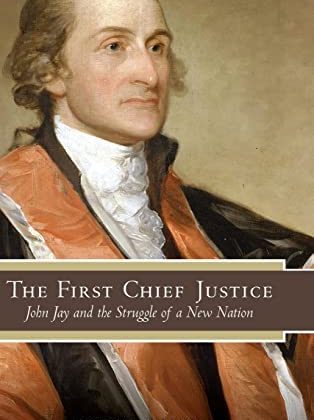

Mark Dillon is Associate Justice of the Appellate Division of the New York State Supreme Court, Second Judicial Department. This interview is based on his book, The First Chief Justice: John Jay and the Struggle of a New Nation (State University of New York Press, 2022).
JF: What led you to write The First Chief Justice?
MD: There are two types of books that address John Jay’s role in our nation’s early history – the actual biographies of Jay, and books about other persons or the general time period where Jay floats in and out of historical events as an important actor. For both forms of books, the focus is almost entirely upon Jay’s endeavors as an attorney, founder, author of the Federalist Papers, primary author of the first NYS constitution, President of the Second Continental Congress, negotiator of two treaties (Treaty of Paris and the Jay Treaty), and Governor of NYS, i.e., Jay’s political accomplishments. Jay’s selection and work as the nation’s first U.S. Chief Justice is glossed over, as writers have tended to ignore the early judiciary that was, in many respects, one step removed from the political issues of the time. No book in our nation’s history, until now, has examined Jay’s unique role in being the first head the nation’s judicial branch of government generally and of the U.S. Supreme Court specifically, in creating a body of American law from scratch. Being the “first” at something is often difficult because there is no prior model to learn from and improve upon. Many of the early decisions of the Jay Court have had enduring legacy and influence on the law from then to today. As an attorney and appellate court judge, I bring a unique and insightful perspective to the subject matter of the book.
JF: In 2 sentences, what is the argument of The First Chief Justice?
MD: The argument of the book, which has never been made by any previous writer, is that John Jay’s personal, political, legal, revolutionary war, and diplomatic experiences tangibly influenced how he approached the role of U.S. Chief Justice, viewed the court’s cases, and shaped law into the future. Each of the eight main cases decided by the Jay Court between 1989 and 1795 are examined in separate chapters, highlighting how Jay’s background influenced the case outcomes. One helped define the separation of powers between the branches of government. One prompted the later ratification of the 11th Amendment. One was the only reported jury trial ever conducted at the U.S. Supreme Court. One created and defined American Admiralty authority over privateering disputes arising on the high seas that broke from pre-existing internationally-recognized law. Two cases were resolved in a manner that adeptly avoided constitutional crises between the judicial, legislative, and executive branches of government, at a time when the powers of each branch, and the legitimacy of the new constitutional structure itself, was uncertain.
JF: Why do we need to read The First Chief Justice?
MD: There are two reasons to read The First Chief Justice. One is that we see today the crucial role that the U.S. Supreme Court plays not only on law, but society, and its staffing and decision-making are recognized as having great importance. The second is that until now, no book has ever been written focused primarily on the cases of the Jay Court and the influence of John Jay on the case outcomes, which thereafter influenced generations of law. The First Chief Justice is not a law book; it is a deeply-researched but easy-to-read 319-page book designed for readers of history who browse the offerings of Barnes & Noble.
JF: Why and when did you become an American historian?
MD: I became a historian upon the publication of my first book of legal history, The Montana Vigilantes 1863-1870: Gold, Guns & Gallows (Univ. of Colorado Press, 2013). The book chronicled the rise of vigilantism in the Montana Territory in the 1860s caused by the discovery of significant deposits of gold, the absence there of law enforcement, and the insecure means of travel in that remote region of the continent. The book covers the facts and circumstances of each of the dozens of vigilante hangings, including a small number of innocents, and the manner in which the courts eventually managed to replace vigilantism as a means of dealing with crime in the Territory. As with the book on John Jay, the research behind the Montana book is meticulous, comprehensive, and reliant upon original-source materials, which is a requirement of any serious book of history.
JF: What is your next project?
MD: I am currently working on a book that examines President Lincoln’s reprieve of death sentences imposed by a military tribunal upon 303 Dakota Indians, in the aftermath of the Dakota Indian War fought in Minnesota in 1862. The Civil War was not the only war that Lincoln fought during his Presidency. Lincoln unexpectedly reprieved 265 of the 303 Dakota convicts, allowing only 38 to be hanged. The book will be original in its focus upon the internal politics and procedures at the White House leading to Lincoln’s decisions to reprieve the 265. As an attorney, he demanded a chance to personally review the record of all 303 trials, and was appalled by the due process violations and unfairness that he saw which led to many of the convictions. He allowed the death sentences to be carried out upon 38 persons where the evidence against them was solid as to the murder of Minnesota settlers and the rape of women, and did so amidst the problems and pressures of the Civil War that competed for Lincoln’s attention. Lincoln’s reprieve decisions, which were rendered in 1863 ahead of the 1864 election, were highly unpopular, but Lincoln said “I will not hang men for votes.” Lincoln’s quote might be the book’s title.
JF: Thanks, Mark!